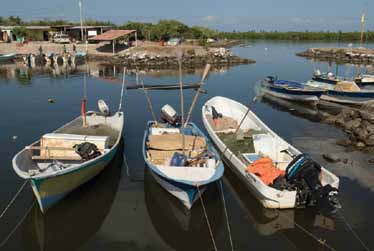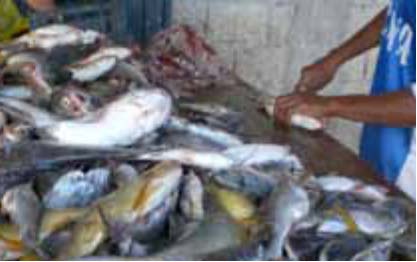Contents | 3 | 4 | 5 | 6 | 7 | 8 | 9 | 10 | 11 | 12 En español
San Blas
Organization and Regulation
key to achieving benefits
for the “U”
Organization and regulation, the basis
of sustainable fishing in San Blas.

Photo: Ernesto Bolado
with conservation measures of marine species. However, the challenge of getting the local, off-shore fishing sector to participate in organizing themselves continues to be monumental.
As early as 2006, many fishermen opposed the construction of a sports marina on the site previously occupied by the commercial and subsistence fishermen. On learning that they would be relocated by Fonatur (National Fund for the Promotion of Tourism) because of the Sea of Cortez Nautical Ladder megaproject, the fishermen feared that they would no longer have a safe place to moor their boats.
But those who organized and created The Association of Fishermen of the Northern Dock at San Blas, Nayarit were able to secure a guarantee from all three levels of government that there would be a space for each and every one of them.
With this infrastructure support, the future site of the “U” was renovated. One hundred and eighty two active members currently hold the concession to the site, “but it benefits around one thousand families both directly and indirectly,” states José Juan Burgueño, secretary of the association.
As a result of their organizing, they have gained better working conditions. It has also led to David Lara standing out as the fishermen’s natural leader and to his becoming a municipal government official.
The sea continues to generously provide them with many profitable species such as: mahi-mahi due to the volume of the catch and its asking price; snook and snapper for the meat’s quality; and other lower priced species such as pacific jack mackrel, pacific jack crevalle, golden mojarra and even ladyfish. Although the fish wholesalers don’t buy these latter species, their white meat is excellent for making ceviche.
However, according to Burgueño, a constant decline in the volume of fish being caught has been noted due to overfishing and pollution.
The large factory ships are most responsible for overfishing, as opposed to the smaller launches, says Buergueño. In fact, in San Blas there are only three ships, which in no way could cause overfishing, he asserts. On the other hand, the Sinoloan fleet is so numerous and well-placed when the fishing bans are lifted, that when fishermen from this town go out to catch shrimp they see their efforts frustrated, adds Burgueño.
Additionally, the size of the mesh on the nets that the Sinaloan shrimpers use is smaller than regulation size, which leads to a higher mortality rate of smaller species that make up the bycatch, he acuses. Killing the juveniles will reduce the future catch because of the loss of reproductive capabilities.
In Sonora and other states, fishermen on smaller boats are organizing to stop the larger ships from entering waters to fish where they don’t belong. In Nayarit, there isn’t this class consciousness nor a sense of solidarity. About 80% of the fishermen in the zone are disorganized.
They are referred to as “free fishermen”, and enjoy a freedom that in this case actually hurts them. A better description would be “displaced fishermen” since their liberty rests on not belonging to any organization, whether a cooperative or non-profit association. They find themselves unable to get fishing permits, because there are only 105 permits available in the state, and 10,000 fishermen.
As soon as the process of restructuring the fishing regulations (currently being directed by Antonio Murillo Olmedo) is completed, the fishermen that organize themselves will be in the position to take action that will put an end to both overfishing and the resulting pollution.
Among other things, what will be required in the new legislation is cleaner, more environmentally friendly boating, such that those enjoying the Gulf waters can, as Brazilian singer-songwriter Roberto Carlos sings, “sail without finding so many oil spots in the sea.”
Currently, fishermen use two-stroke motors. This means that much of the gasoline and oil used goes directly into the sea. Part of the solution to this problem can be found in the use of 4-stroke outboard motors. However, fishermen can’t receive financial subsidies if they don’t have fishing permits.
The association’s struggle continues to show improvement in working conditions as well as in the general state of the dock which is at the core of the struggle. Without one or the other, speaking of high-tech fishing techniques sounds a little strange given the primitive conditions of the wharf.
“We want the “U” to be cobbled, to have green areas and staircases that are completed, as well as toilets and sewer lines, since currently people defecate in the open,” says Burgueño.
*Self-described social journalist, editor of the local bulletin Devenir
